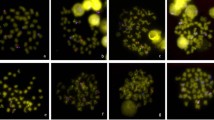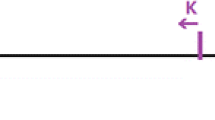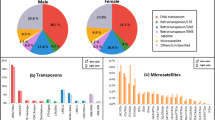Abstract
Crossing the cyprinids diploid blunt snout bream Megalobrama amblycephala (BSB) and Carassius auratus red var. (RCC) generated sterile triploid (3nRB) and fertile tetraploid (4nRB) hybrid offspring. Utilizing inverted terminal repeats (ITRs) of transposon Tdr1 from Danio rerio as PCR primer, the results showed that evident change in the number of Tc1-like transposons in 4nRB relative to BSB occurred, whereas such change did not arise in 3nRB compared to BSB. No Tc1-like transposon was found in RCC. A novel transposon was isolated from both BSB and 3nRB and designated as Tma1, which consisted of multiple copies after dot-blot hybridization. Based on the analysis of PCR amplified flanking sequence, characterization of Tma1 indicated that this element flanked by a duplicated TA dinucleotide and harbored an ITR of about 224 bp. Tma1 also harbored an incomplete transposase gene. Another novel transposon designated as Tte1 was detected in 4nRB, which harbored an ITR of roughly 130 bp and consisted of multiple copies, but had no transposase gene. The analysis of PCR amplification and Southern blot hybridization showed that DNAs of 4nRB, which were hybridized to DIG-labeled pTma1, did not give band by PCR with Tma1 primer, on the other hand, 7 of 15 DNA samples from BSB, which were hybridized to DIG-labeled pTte1, did not produce band by PCR with Tte1 primer. These results suggest that Tte1 may be a recent invasion in BSB population and burst in 4nRB offspring. Our data provide clues as to the possible role of transposons as a driving mechanism for genomic evolution.





Similar content being viewed by others
References
Abrusan G, Krambeck HJ (2006) Competition may determine the diversity of transposable elements. Theor Popul Biol 70:364–375
Benjamin B, Yves B, Corinne AG (2007) Assembly of the Tc1 and mariner transposition initiation complexes depends on the origins of their transposase DNA binding domains. Genetica 130:105–120
Bingham PM, Kidwell MG, Rubin GM (1982) The molecular basis of P-M hybrid dysgenesis: the role of the P element, a P-stain-specific transposon family. Cell 29:995–1004
de Boer JG, Yazawa R, Davidson WS, Koop BF (2007) Bursts and horizontal evolution of DNA transposons in the speciation of pseudotetraploid salmonids. BMC Genomics 8:422
Emmons SW, Yesner L, Ruan KS, Katzenberg D (1983) Evidence for a transposon in Caenorhabditis elegans. Cell 32:55–65
Evgen’ev MB (2007) Mobile elements and genome evolution. Mol Biol 41(2):203–213
Evgen’ev MB, Zelentosova H, Shostak N, Kozitsina M, Braskyi V, Lankenau DH, Corces V (1997) Penelope, a new family of transposable elements and its possible role in hybrid dysgenesis in Drosophila virilis. Proc Natl Acad Sci USA 94:196–201
Feschotte C, Pritham EJ (2007) DNA transposons and the evolution of eukaryotic genomes. Annu Rev Genet 41:331–368
Finnegan DJ (1985) Transposable elements in eukaryotes. Int Rev Cytol 93:281–326
Fontdevila A (2005) Hybrid genome evolution by transposition. Cytogenet Genome Res 110:49–55
Hoegg S, Brinkmann H, Taylor JS, Meyer A (2004) Phylogenetic timing of the fish-specific genome duplication correlates with the diversification of teleost fish. J Mol Evol 59:190–203
Ivics Z, Hackett PB, Plasterk RH, Izsvak Z (1997) Molecular reconstruction of Sleeping Beauty, a Tc1-like transposon from fish, and its transposition in human cells. Cell 91:501–510
Izsvák Z, Ivics Z, Hackett PB (1995) Characterization of a Tc1-like transposable element in zebrafsh (Danio rerio). Mol Gen Genet 247:312–322
Koga A, Suzuki M, Inagaki H, Bessho Y, Hori H (1996) Transposable element in fish. Nature 383:30
Labrador M, Farre M, Utzet F, Fontdevila A (1999) Interspecific hybridization increases transposition rates of Osvaldo. Mol Biol Evol 16(7):931–937
Lampe DJ, Churchill ME, Robertson HM (1996) A purified mariner transposase is sufficient to mediate transposition in vitro. EMBO J 15(19):5470–5479
Liu B, Wendel JF (2000) Retrotransposon activation followed by rapid repression in introgressed rice plants. Genome 43:874–880
Liu ZJ, Li P, Kucuktas H, Dunham RA (1999) Characterization of nonautonomous Tc1-like transposable elements of channel catfish (Ictalurus punctatus). Fish Physiol Biochem 21:65–72
Liu SJ, Qin QB, Xiao J, Lu WT, Shen JM, Li W, Liu JF (2007) The formation of the polyploid hybrids from different subfamily fish crossings and its evolutionary significance. Genetics 176:1023–1034
Lohe AR, Moriyama EN, Lidholm DA, Hartl DL (1995) Horizontal transmission, vertical inactivation, and stochastic loss of mariner-like transposable elements. Mol Biol Evol 12:62–72
Miskey C, Izsvak Z, Kawakami K, Ivics Z (2005) DNA transposons in vertebrate functional genomics. CMLS Cell Mol Life Sci 62:629–641
O’Neill RJW, O’Neill MJ, Graves JAM (1998) Undermethylation associated with retroelement activation and chromosome remodelling in an interspecific mammalian hybrid. Nature 393:68–72
Radice AD, Bugaj B, Fitch DHA, Emmons SW (1994) Widespread occurrence of the Tcl transposon family: Tcl-like transposons from teleost fish. Mol Gen Genet 244:606–612
Reed KM (1999) Tc1-like transposable elements in the genome of lake trout (Salvelinus namaycush). Mar Biotechnol 1:60–67
Tiersch TR, Chandler RW, Wachtel SS (1989) Reference standards for flow cytometry and application in comparative studies of nuclear DNA content. Cytometry 10(6):706–710
Yu XJ (1989) China freshwater fisheries chromosome. Science Publishing House, Beijing, Chinese, pp 44–75
Zhang WM (ed) (2002) A laboratory manual for modern molecular biology. Science Press, Beijing, Chinese, pp 278–284
Acknowledgments
This research was supported by grants from the National Natural Science Fund for Distinguished Young Scholars (Grant No. 30725028), the National Basic Research Program of China (973) (Grant Nos. 2007CB109206), specially appointed Professor for Furong Scholars of Hunan Province, and Scientific Research Fund of Hunan Provincial Education Department (No. 04C352). We are very thankful to the anonymous referees for their useful comments on an earlier version of this manuscript.
Author information
Authors and Affiliations
Corresponding author
Additional information
C. You contributed equally to this study.
Rights and permissions
About this article
Cite this article
Liu, D., You, C., Liu, S. et al. Characterization of a Novel Tc1-Like Transposon From Bream (Cyprinidae, Megalobrama) and Its Genetic Variation in the Polyploidy Progeny of Bream–Red Crucian Carp Crosses. J Mol Evol 69, 395–403 (2009). https://doi.org/10.1007/s00239-009-9295-5
Received:
Accepted:
Published:
Issue Date:
DOI: https://doi.org/10.1007/s00239-009-9295-5




